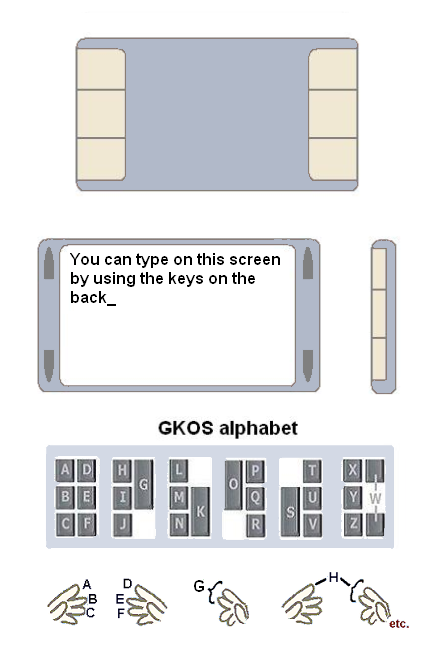 |
The GKOS keyboard
principle |
|
Other combinations of keys produce different functions such as space and backspace. Pressing all six keys at once toggles between letters mode and numbers mode (which operates similarly). The thumbs can be used to control the mouse functions on the front panel by using e.g. a Pointing stick-type device. Consequently, most of the front panel can be reserved for the display. As the GKOS typing system is unfamiliar to most people, there is a learning curve before considerable text entry speeds can be reached. But with practice, speeds of 50 WPM (= 250 characters per minute) have been reported. Practical limit has been estimated to be around 60 WPM based on studies made on other physical two-hand chording keyboards. The GKOS keyboard is intended for replacing the QWERTY
where there
is not enough room for a large number of keys but still all PC keyboard
functions are required. It has not been used in commercial
applications except Crichton barcoding
audio PDAs. There is, however, software for
trying this concept on the PC keyboard using keys sdf/jkl,
and there are instructions
and software available for building small
GKOS devices based on PIC and Atmel (Arduino) microcontrollers. A GKOS chording keyboard application development for
touch screens was started on the GKOS
Google Group on May 25, 2009. Then, on May 8th, 2010, a GKOS
iPhone application and on
October 3rd, 2010 an Android GKOS application became
available where you can type on GKOS keys
on the touch screen with your thumbs. GKOS is an open standard, meaning anybody is free to
manufacture and
use it, and it does not include any intellectual property rights by the
inventor. The concept has been presented
at ITU-R as an example of possible future text entry methods. GKOS
became public domain in October 2000.
The main GKOS website: gkos.com Page created by S.Tiainen 4 June 2008 |
 |